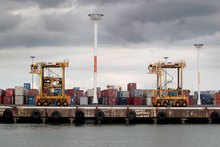Jun 19, 2013

New Zealand’s current account deficit narrowed as expected in the first quarter as volumes and prices of dairy exports rose and visitors spent more, lifting the balance on goods and services.
The current account deficit fell to $663 million in the three months ended March 31, from a revised $3.2 billion in the fourth quarter of 2012, according to Statistics New Zealand. The annual gap narrowed to about $10.1 billion, or 4.8 per cent of gross domestic product, from $10.5 billion, or 5 per cent, three months earlier, about matching the forecasts in a Reuters survey.
The New Zealand dollar was almost unchanged after the release, recently trading at 79.87 US cents.
Strong demand for New Zealand’s dairy exports, the biggest commodity shipped overseas, has helped keep a check on the goods balance, though the improved balance of payments position may only be temporary. The impact of drought in the first quarter is likely to start showing up in the second quarter while imports are expected to resume their advance.
“We expect a volatile goods balance over 2013,” economists at Westpac said before the report was released. “The drought will hit export volumes, particularly in Q2, but increasing export (dairy) prices are likely to more than offset this by the end of the year. At the same time, imports are likely to increase as the Canterbury rebuild continues to ramp up.”
The Treasury is forecasting the deficit will rise to $16.6 billion, or 6.5 per cent of gross domestic product, by 2017, with unusual elements including insurance flows stemming from the Canterbury rebuild.
The balance on goods was a surplus of $1.15 billion, from a deficit of $246 million three months earlier. Imports fell as the country brought in less petroleum and petroleum products.
The balance of services improved to a surplus of $886 million in the first quarter from a deficit of $359 million three months earlier as overseas visitors increased spending and imports of services fell on lower payments for transportation services.
The balance on income was little changed in the first quarter at a deficit of $2.57 billion from a gap of $2.55 billion three months earlier. The slight increase reflected lower dividend income earned by foreign investors, partly offset by lower profits earned by New Zealand companies’ overseas subsidiaries, the government statistician said.
New Zealand’s international liability position fell to $146.7 billion, or 69.3 per cent of GDP, at March 31, from $149.6 billion, or 71.4 per cent three months earlier. The improvement was attributed to rising overseas equity markets, which helped lift the value of New Zealand’s offshore assets.
“Almost a third of New Zealand’s international assets are held in overseas sharemarkets,” said Statistics New Zealand balance of payments manager Matthew Haigh. “Rising prices in these markets helped boost our asset values by $2.4 billion this quarter.”
Outstanding claims on overseas reinsurers for the Canterbury earthquakes were an estimated $9.5 billion as at March 31.
New Zealand’s net international debt fell $2.5 billion to $139.1 billion as at March 31, reflecting a net $4.2 billion decline in bank borrowing and a net $1.1 billion increase in government borrowing.
Net external debt shrank to 65.6 per cent of GDP, the lowest ratio since Sept. 30, 2005, from 68 per cent as at December 31, 2012.
The balance of payments measures total goods and services which cross the nation’s borders, showing how reliant the country is on foreign funding.
